Note. This is a complex procedure, and before starting work, you should carefully read the contents of the paragraph. For ease of installation, before removing, mark the installation position of the appropriate brackets and the routing of hoses, wires and cables.
Note. On 2.0L engines, due to limited accessibility, it is not possible to remove the cylinder head while the engine is on the vehicle unless significant additional disassembly is first performed* (e.g. remove the front subframe and related components). Therefore, a description of the procedures for removing and installing the cylinder head is given in chapter 2D, taking into account the fact that the engine assembly with the gearbox is removed from the car.
Removing
1. Disconnect the ground wire from the battery (see «Disconnecting the battery»).
2. Drain the coolant from the cooling system as described in chapter 1B.
3. Remove the brake vacuum pump as described in chapter 9.
4. Remove the timing belt as described in paragraph 7.
5. After removing the timing belt, remove the single bolt securing the right engine/gearbox support bracket to the cylinder head. Retain all of the bracket-to-cylinder block bolts, and then install the upper engine support bracket-to-mount bracket and securely tighten the appropriate nuts and bolts. You will need to securely support the engine/gearbox assembly throughout the following procedure.
6. If the cylinder head needs to be repaired, remove the camshaft sprocket and camshaft (see paragraphs 9 and 11).
7. Do the following (see chapter 4B):
- A) remove the air filter housing;
- b) remove the intake and exhaust manifolds;
- V) disconnect the fuel return hose from the extreme nozzle and remove it;
- G) Loosen the cap nuts and disconnect the fuel lines from the fuel injectors and high pressure fuel pump. Remove pipelines;
- d) if the cylinder head is to be overhauled, remove the injectors.
8. Remove the cylinder head cover as described in paragraph 4.
9. Remove the fuel filter as described in chapter 1B.
10. Turn out a bolt and remove the plastic case of the filter together with a sealing ring (pic. 13.10). Discard the O-ring; when installing, use a new one.
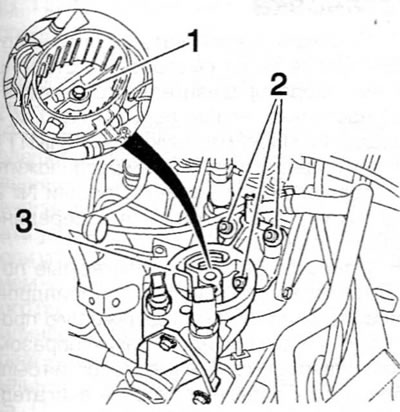
Pic. 13.10. Remove the bolt (1) and remove the fuel filter housing, and then remove the three bolts (2) and remove the filter/thermostat housing (3) from cylinder head (engines 1.9 l)
11. Turn out three bolts (pay attention to the installation position of the sealing washer), used to attach the fuel filter/thermostat housing to the front of the cylinder head. Disconnect the coolant hose connecting the body to the coolant line, and then separate the body from the cylinder head. Remove the body gasket and discard it; when installing, use a new one.
12. Turn away a nut and disconnect a wire of a food from a corresponding incandescent candle. Remove washers.
13. Turn out a bolt of fastening of the pipeline of a cooling liquid to the left end of a head of cylinders.
14. Be convinced that electroconducting and hoses are liberated from all corresponding clips or directings on a head of cylinders and are located aside.
15. Working in the reverse order shown in fig. 13.32, gradually loosen 10 cylinder head bolts, half a turn at a time, until all bolts can be removed by hand.
16. After unscrewing all bolts of fastening of a head of cylinders separate a head of cylinders from the block of cylinders and an adjusting pin, swinging it. The Peugeot/Citroen special tool for this procedure consists of two metal rods with ends bent at a right angle. Do not pry with makeshift levers inserted between the mating surfaces of the head and cylinder block, as this may damage the surfaces under the gasket. Remove the cylinder head; Seek outside help if possible.
17. Remove the gasket from the top plane of the block, paying attention to the dowel pin. If the dowel pin is loose, remove it and store it in a safe place along with the head. Do not throw away the gasket; required for identification purposes (see items 22-25).
18. If the cylinder head must be disassembled for overhaul, remove the camshaft and tappets as described in paragraph 11, and then refer to chapter 2D.
Preparing for installation
19. Before installation of a head of cylinders carefully clear interfaced surfaces of a head of cylinders and the block of cylinders. Use a hard plastic or wooden scraper to remove gasket residue and carbon deposits. Clean the piston bottoms. Be extremely careful when cleaning - the soft aluminum alloy is easily damaged. Do not allow carbon deposits to enter the lubrication and coolant channels. This is especially important for the lubrication system, since carbon deposits can block the oil supply to the engine elements. Cover the cooling and lubrication channels and bolt holes in the cylinder block/crankcase with adhesive tape and paper. In order to prevent the removed deposits from getting into the gaps between the pistons and the cylinder walls, put a little grease into the gap. After cleaning each piston, take a small brush and remove all traces of grease and carbon from the gap, then wipe everything with a clean cloth. Also clean all pistons.
20. Check the mating surfaces of the cylinder block and cylinder head for scoring, deep scratches and other damage. If they are small, carefully remove them with a file. But if they are large, the only alternative to replacement may be only mechanical processing.
21. If deformation of the mating surface of the cylinder head is suspected (under the gasket), check this surface with a ruler. If necessary, contact chapter 2D.
22. When buying a new cylinder head gasket, make sure that the gasket has the correct thickness. Six different shim thicknesses are available to precisely set the distance between the cylinder head mating surface and the piston crowns. The thickness of the gasket can be determined by carefully examining the protrusion on the gasket located in front of cylinder number 1 (pic. 13.22). The ledge can have from 3 to 7 holes. First two holes (hole group A) show engine type (DW8), they are on all gaskets and have no real meaning. But the last group, which includes from 1 to 5 holes (group of holes B), indicates the shim thickness as described below.
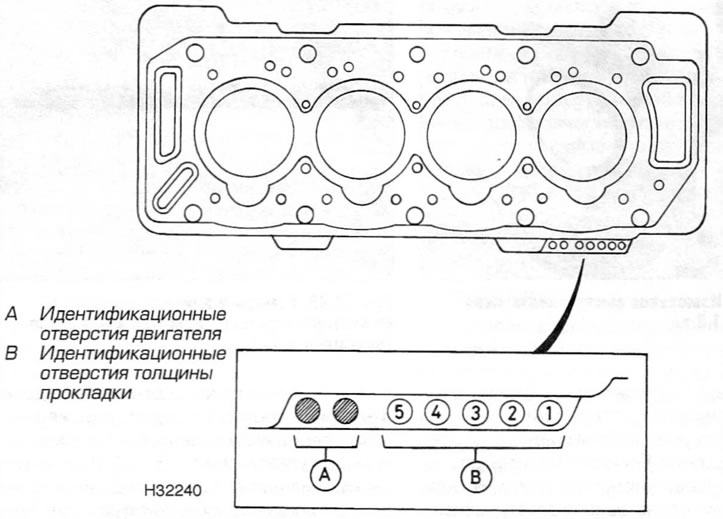
Pic. 13.22. Identification holes on the cylinder head gasket (engines 1.9 l)
| Number of holes | Gasket thickness |
| (hole positions) | (in position) |
| 1 (1) | 1.26 mm |
| 2 (1 and 2) | 1.30 mm |
| 3 (1,2 and 3) | 1.34 mm |
| 4 (1,2,3 and 4) | 1.38 mm |
| 5 (1,2,3,4 and 5) | 1.42 mm |
| 2 (1 and 5) | 1.46 mm |
The correct required gasket thickness is selected by measuring the piston protrusion as described below.
23. Make sure the flywheel is correctly locked in position so that pistons #1 and #4 are exactly at TDC. Attach the dial indicator securely to the cylinder block so that its plunger can be easily rotated from contact with the mating surface of the cylinder block to the piston crown and back. Zero the indicator scale by bringing the tip of the plunger to the mating surface of the cylinder block, and then gently move the indicator plunger to the bottom of the No. 1 piston and measure its protrusion (pic. 13.23). Take measurements on the front and back of the piston crown and calculate the average of the two measurements. This will be the protrusion of the piston. Repeat this procedure on piston #4.
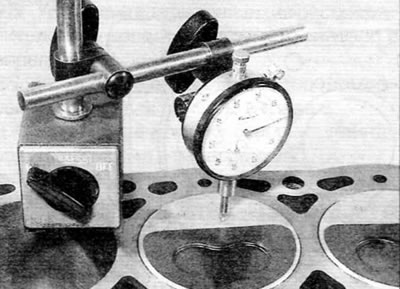
Pic. 13.23. Piston protrusion measurement (engines 1.9 l)
24. Remove the locking tool and then turn the crankshaft half a turn (180°) clockwise to bring pistons No. 2 and 3 to TDC. Make sure the crankshaft is properly aligned, and then measure the protrusion of pistons No. 2 and 3. Once all four pistons have been measured, turn the crankshaft another half turn (180°) clockwise to bring the No. 1 and 4 pistons back to TDC, and then lock the flywheel again.
25. Using the largest protrusion of the four pistons, select the correct required gasket thickness using the table below:
| Piston protrusion | Required gasket thickness |
| 0.510 - 0.549 mm | 1.26 mm |
| 0.550 - 0.589 mm | 1.30 mm |
| 0.590 - 0.629 mm | 1.34 mm |
| 0.630 - 0.669 mm | 1.38 mm |
| 0.670 - 0.709 mm | 1.42 mm |
| 0.710 - 0.750 mm | 1.46 mm |
26. Carefully inspect the cylinder head bolts for signs of thread or head damage and for signs of corrosion. If the bolts are in good condition, measure the length of each bolt from the back of the head to the end of the guide (unthreaded) area at the base of the bolt shank (pic. 13.26). Bolts can be reused if their length does not exceed 125.5 mm. Keep in mind that if the bolt is reworked to expose the spacer (see par. 28), the final installation of the cylinder head will require a new bolt.
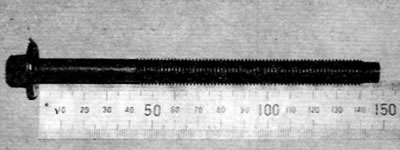
Pic. 13.26. Measure the length of each bolt from the back of the head to the end of the bolt (engines 1.9 l)
Note. Given the stresses that occur in the cylinder head bolts, it is strongly recommended to replace them, regardless of their external condition.
Installation
27. Turn the crankshaft clockwise (viewed from the timing belt side) until pistons 1 and 4 are past bottom dead center (NMT) and began to rise, and then position them in the middle of the upward stroke. Pistons #2 and #3 will also be in the middle of their stroke, but downstroke.
28. Clean the mating surfaces of the head and cylinder block. Correctly install the proper gasket on the cylinder block with the identification holes facing the front of the engine and next to the #1 cylinder (flywheel side). Make sure there is a dowel pin in place: at the end of the cylinder block where the timing belt is located. Be aware that due to the presence of only one locating pin, the gasket may move when installing the cylinder head (due to engine tilt), especially when the cylinder head is installed on the engine without removing it from the vehicle. In the worst case, the pistons and/or valves can hit the gasket causing engine damage. To avoid this problem, cut off the head from «old» cylinder head bolt and saw through the slot on the end of the bolt so that the bolt can be turned with a screwdriver. Insert a bolt into one of the bolt holes on the end of the engine block where the flywheel is located, and then align the gasket using the bolt and dowel pin. This will hold the gasket in place when installing the cylinder head.
29. Together with an assistant, carefully lower the cylinder head onto the block, guided by the locating pin.
30. Apply some lubricant to the threads and to the back of the heads of the cylinder head bolts. Peugeot/Citroen recommends Molykote G Rapid Plus (can be purchased from a dealer).
31. Gently insert each bolt into the appropriate hole (don't let them fall) and screw them in by hand only.
32. Working gradually and in the prescribed sequence, using a torque wrench and a suitable socket, tighten the cylinder head bolts to the prescribed torque according to stage 1 (pic. 13.32).
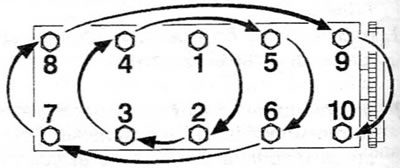
Pic. 13.32. Cylinder head bolt tightening sequence (engines 1.9 l)
33. After tightening all the bolts according to step 1, working again in the same sequence, tighten each bolt to the prescribed torque according to step 2.
34. Finally, using a socket and extension, tighten the bolts to the specified angle according to stage 3. To ensure accuracy, it is recommended to use a goniometer at this stage of tightening. If a goniometer is not available, mark the relative position with white paint on the bolt head and cylinder head before tightening. These marks can then be used to check that the bolt has turned to the correct angle during the tightening process.
35. If necessary, install the camshaft and / or camshaft sprocket (see paragraphs 9 and 11). If the cylinder head has been overhauled, check the valve clearances before proceeding with the next steps.
36. Set up solid supports (or use a lifting device) under the engine/gearbox, and then remove the support bracket from the right engine/gearbox mount. Screw in the bracket-to-cylinder head bolt and tighten to the specified torque.
37. Install the timing belt as described in paragraph 7.
38. Screw in a bolt of fastening of the pipeline of a cooling liquid and reliably dock an electric socket of incandescent candles.
39. Clean and dry the mating surfaces and install the fuel filter/thermostat housing to the cylinder head using a new gasket. Screw in the housing mounting bolts (install the sealing washer on the bolt located on the inside of the filter housing) and tighten them to the prescribed torque. Connect the coolant hose securely to the body.
40. Install a new o-ring on the base of the plastic fuel filter housing and install the housing by tightening the appropriate bolt to the specified torque.
41. Install the cylinder head cover (see paragraph 4).
42. Do the following (see chapter 4B):
- A) install injectors (if removed);
- b) install the fuel lines connecting the high pressure fuel pump to the injectors and connect the return hoses to the injectors;
- V) install the manifolds and air cleaner housing.
43. Install the brake vacuum pump as described in chapter 9.
44. Install a new fuel filter and charge the cooling system as described in chapter 1B.
45. Connect the battery, then fill and bleed the fuel system as described in chapter 4B.
